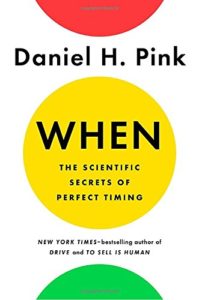By Rose O. Sherman, EdD, RN, NEA-BC, FAAN
 Leaders know the importance of timing in their work and lives but what we may not know is that there science behind timing that can inform our lives and work. In his new book, When: The Scientific Secret of Perfect Timing, Daniel Pink takes cutting edge research and explains how we can use it to our advantage. His findings have important implications in healthcare environments.
Leaders know the importance of timing in their work and lives but what we may not know is that there science behind timing that can inform our lives and work. In his new book, When: The Scientific Secret of Perfect Timing, Daniel Pink takes cutting edge research and explains how we can use it to our advantage. His findings have important implications in healthcare environments.
How We Move Through Our Day
Pink writes that we do certain kinds of work better in the morning. The research indicates that we tend to move through the day in three stages – a peak, a trough, a recovery. And most of us move through it in that order. Those of us who are strong night owls go in the reverse order. But during the peak, we’re better at analytic work, work that requires heads-down focus, vigilance, attention, batting away distractions – auditing a financial statement, writing a legal brief. We perform better on tests and interviews when done in the morning. In healthcare, the research shows some interesting data related to safety and quality such as:
- Anesthesia adverse events are far more likely to occur in the afternoon.
- Detection of polyps during colonoscopy significantly declines as the afternoon.
- There is a 38% decline in handwashing by healthcare workers in the afternoon.
Our emotional balance rises through the morning, dips in the afternoon and rises again in the early evening. Research has also shown that negativity in meetings is highest in the afternoon hours between 1PM and 4PM when most of the population experiences a drop in energy. Although there is a decline in vigilance in the afternoon, restorative breaks especially those involving movement can have an impact. The research indicates that it is lunch breaks (often skipped in healthcare settings) which allow detachment that are the most critically important to promote occupational health and well-being especially for those in cognitively or emotionally demanding jobs. Short naps 20 minutes in duration have also been found to be the most restorative.
Other Important Points Relative to Timing
- Time markers can serve as powerful new beginnings – ex. Birthday, New Year, First Day of the Month. The research indicates that we will be most effective in building new habits if we use these markers and encourage patients to use them.
- Teams can lose momentum on projects at the midpoint and need to be intentional in understanding this. Slumping at a midpoint of anything is a well-documented phenomena. Setting interim goals is important to a loss of momentum.
- There are times when it is good to go first according to research such as when you are on the ballot with other candidates or when you are interviewing for a prize or job against a strong competitive field.
- It is best to approach leaders about new ideas, raises or promotions in the morning.
- We assign the greatest weight to how experiences end. Ending shape many of our opinions and subsequent decisions. Endings can be a powerful motivational force. In healthcare, this is likely to mean that the discharge experience is a powerful force in how patient satisfaction surveys are answered.
- There is an overwhelming preference of people to want to hear the bad news first and then the good news although that is not the practice in most healthcare settings.
Pink’s findings have important implications for nursing leaders especially around quality and safety issues. There are significant things that could be done to improve care if we paid attention to the evidence. He contends that in leadership, we spend our time considering how we will do something and not enough thinking about the relevance of timing.
Read to Lead
Pink, D. H. (2018). When: The Scientific Secrets of Perfect Timing. New York: Riverhead Books.
© emergingrnleader.com 2018


 LinkedIn
LinkedIn Instagram
Instagram